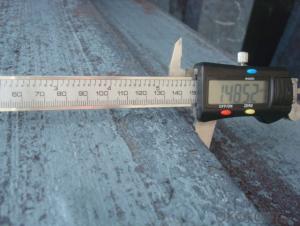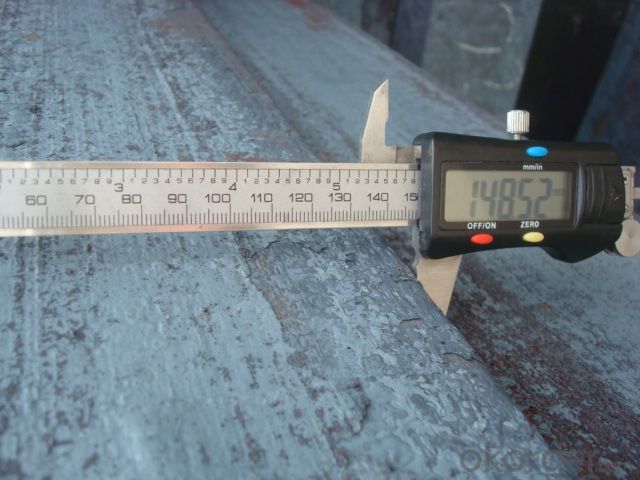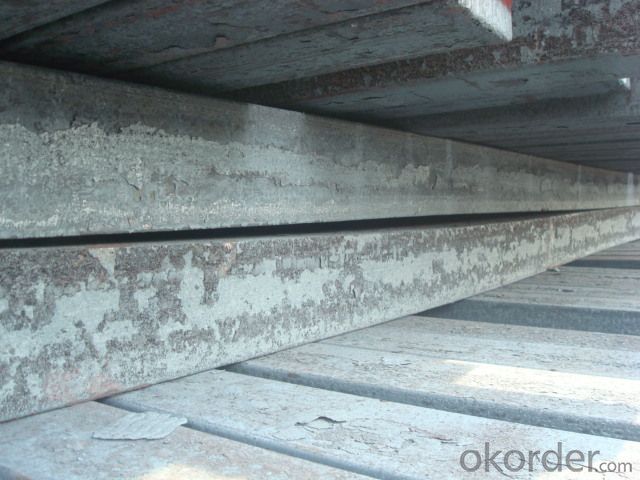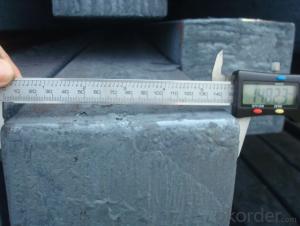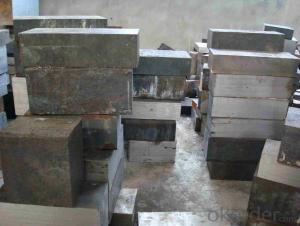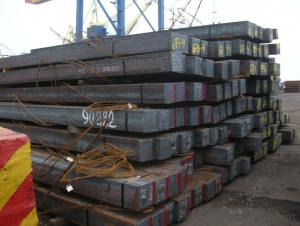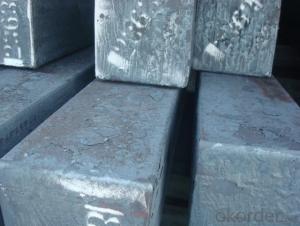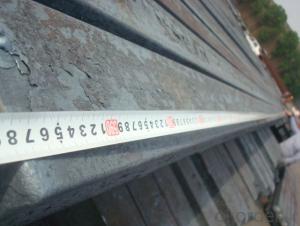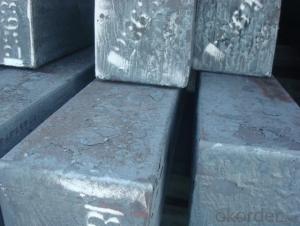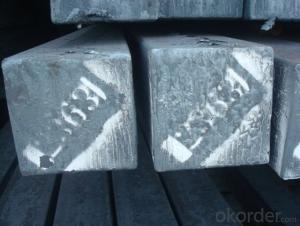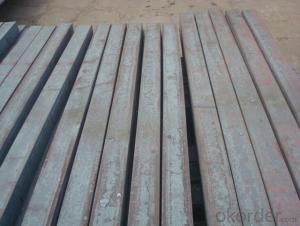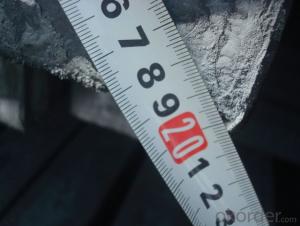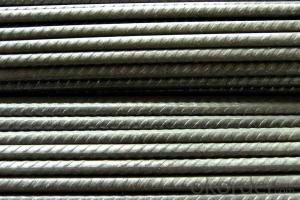Continue Casting Steel Billet by Blasting Furnace
- Loading Port:
- Tianjin
- Payment Terms:
- TT OR LC
- Min Order Qty:
- 1000 m.t.
- Supply Capability:
- 100000 m.t./month
OKorder Service Pledge
OKorder Financial Service
You Might Also Like
Continue Casting Steel Billet by Blasting Furnace
1.Structure of Continue Casting Steel Billet by Blasting Furnace
Continue Casting Steel Billet by Blasting Furnace is the raw material of all kinds of steel mill. Billet section of square, round, flat, rectangular and abnormity, etc Several, mainly related to shape of rolled products. Simple rolled section steel, choose cross section of square billet or rectangular billet. rolling The sector products such as flat steel, Angle steel, select the rectangular billet or slab. Had better profiled billet when production beams, channels, and in rolling process Lines and improve the yield. The raw material of round billet is the production of seamless tube.
2.Main Features of Continue Casting Steel Billet by Blasting Furnace.
Continue Casting Steel Billet by Blasting Furnace section size should meet the requirements of rolling deformation and finished product quality, but also roll strength and biting condition of restrictions. General steel Billet section height H. And the roll diameter D The ratio of the ( namely H/D) Should be less than or equal to zero 0.5 . Length of steel billet by finishing temperature, Rolling time and the length of the product Or times ruler. When heated too long accident prone to bump the furnace wall of steel, too short, furnace bottom utilization rate is not high, influence the heating furnace production. For the production Choose a variety of steel and steel billet, should consider the affinities of billet, as far as possible in order to improve the productivity of the roughing mill, simplify the stock management of workshop.
There are three shapes of the steel billets: square billet, slab, rectangular billet The Chinese billet, rectangular billet is mainly suitable for rolling hot rolled strip, building reinforced bar, Ordinary wire, high speed wire rod and various small profile. Of the slab are mainly used for rolling plate and hot coil sheet.
3. Continue Casting Steel Billet by Blasting Furnace Images

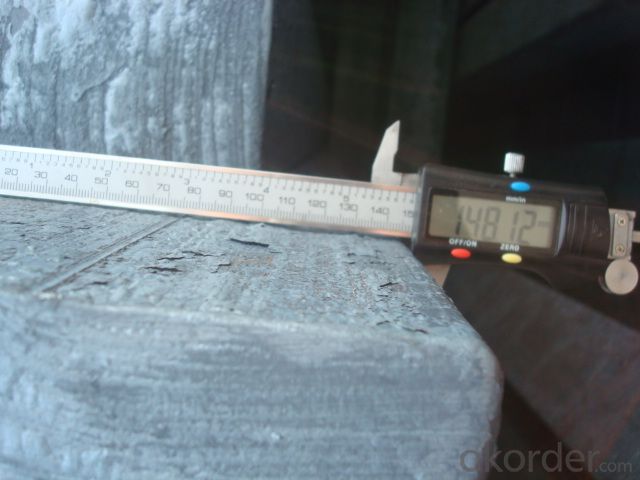
4. Continue Casting Steel Billet by Blasting Furnace Specification
Continue Casting Steel Billet by Blasting Furnace rolled steel, after processing can be used for mechanical parts, forging parts, processing all kinds of steel, steel Q345B channel steel, wire rod is the role of the billet. Steel billet is used in the production of semi-finished products, generally cannot be used directly for the society. Steel billets and steel are strictly divided into standard, cannot decide to whether the business enterprise of the final product, and according to unified standards to perform the whole society. Typically, billet and the steel is relatively easy to distinguish, but for some steel billet, and have the same specification and same steel purposes (such as rolling tube billet), whether can be used for other industries, whether through steel processing process, whether through a finished product rolling mill processing to distinguish
Material standard The editor Range of thickness: 150-240 - mm + / - 5 mm width range: 880-1530 - mm + / - 20 mm Length: 3700-10000 - mm + / - 500 - mm Cross-sectional size: 64 * 64; 82 * 82; 98 * 98; 124 * 124; 120 * 150; 152 * 164; 152 * 170 mm Length: 9000 mm Section of tolerance: billet: 1.0 + / - 2.0-1.0 + / - 1.0 mm slab: width: + / - 2.0 mm thickness: + / - 3.0 mm The length tolerance: + / - 200 mm Section diagonal tolerance: 3.5-8.0 MM Billet section size protrusions requirements: < 1242 mm, do not allow; > = 1242 mm, < = 2 mm 1242 mm, < = 3 mm Beheading (shear) extension deformation: < 1242 mm billet: no control; The slab: < = 15 mm Surface tilt: no more than billet section 0.1 Bending: every 1 m length is not more than 10 mm The distortion: length < = 5 m, < = 11. ; The length of the < = 7.5 M, < = 5. Material % 3 sp/PS chemical composition: C Mn Si S P
5.FAQ of Continue Casting Steel Billet by Blasting Furnace
We have organized several common questions for our clients,may help you sincerely:
①How about your company?
A world class manufacturer & supplier of castings forging in carbon steel and alloy steel,is one of the large-scale professional investment casting production bases in China,consisting of both casting foundry forging and machining factory. Annually more than 8000 tons Precision casting and forging parts are exported to markets in Europe,America and Japan. OEM casting and forging service available according to customer’s requirements.
②How to guarantee the quality of the products?
We have established the international advanced quality management system,every link from raw material to final product we have strict quality test;We resolutely put an end to unqualified products flowing into the market. At the same time, we will provide necessary follow-up service assurance.
③Could I know the process of the producing?
Sure.Steel billet is produced by the method of through three processes: It is through the steelmaking system of continuous casting equipment, directly by the molten steel pouring into billet; The second is the steelmaking system in the production of steel ingot casting billet through system of steel rolling rolling equipment or processing of steel semi-finished products; Three is the steelmaking system production of steel ingot by forging the semi-finished product processing equipment.
- Q: What is the role of steel billets in the construction of commercial buildings?
- Steel billets play a crucial role in the construction of commercial buildings as they are the primary raw material used for manufacturing structural steel sections. These sections are used to construct the framework, columns, beams, and other load-bearing elements of the building. The high strength and durability of steel make it an ideal material for commercial buildings, as it can withstand heavy loads, resist deformation, and provide structural integrity. Steel billets are melted and cast into various shapes and sizes to create different sections, such as I-beams, H-beams, channels, angles, and plates. These sections are then fabricated, welded, and assembled to form the skeletal structure of the building. Steel billets are often utilized to produce long steel bars or rods, which are commonly used as reinforcement in concrete structures. Reinforced concrete is widely used in commercial buildings due to its ability to combine the compressive strength of concrete with the tensile strength of steel. Moreover, steel billets are essential in providing stability and support to the overall structure. They help distribute the weight and loads evenly throughout the building, ensuring the safety and integrity of the construction. Additionally, steel is a highly fire-resistant material, reducing the risk of damage in case of fire incidents and enhancing the overall safety of the building. Furthermore, steel billets offer design flexibility and cost-effectiveness. They can be easily fabricated and customized to meet the specific requirements of the building design, allowing architects and engineers to create innovative and efficient structures. Steel structures are also lightweight compared to traditional construction materials, reducing the overall weight of the building and potentially lowering construction costs. In conclusion, steel billets are integral to the construction of commercial buildings as they provide the necessary strength, durability, and stability required for the structural framework. Their versatility, fire-resistance, and cost-effectiveness make them a preferred choice for architects, engineers, and contractors in the construction industry.
- Q: Can steel billets be coated for improved corrosion resistance?
- Yes, steel billets can be coated for improved corrosion resistance. Coating steel billets with a protective layer helps to prevent corrosion by acting as a barrier between the steel and its surrounding environment. There are several coating methods available for steel billets, including hot-dip galvanizing, electroplating, and powder coating. Hot-dip galvanizing involves immersing the steel billets in a bath of molten zinc, which forms a thick, durable coating on the surface. This zinc coating provides excellent corrosion protection, even in harsh environments. Moreover, it offers a sacrificial layer that corrodes preferentially to the steel, further enhancing its corrosion resistance. Electroplating is another commonly used method for coating steel billets. In this process, a thin layer of another metal, such as zinc, nickel, or chromium, is deposited onto the surface of the billets through an electrochemical reaction. The electroplated layer acts as a barrier against corrosion and can also provide aesthetic appeal. Powder coating is a technique where a dry powder is applied to the surface of the steel billets and then cured under heat to form a protective coating. This method offers excellent corrosion resistance and also provides additional benefits, such as improved impact resistance and flexibility. By applying suitable coatings to steel billets, their corrosion resistance can be significantly improved, increasing their lifespan and reducing maintenance requirements. However, the choice of coating method should consider factors such as the intended application, environmental conditions, and cost-effectiveness.
- Q: How do steel billets contribute to the overall recyclability of a product?
- The overall recyclability of a product is significantly improved with the use of steel billets. These semi-finished steel products are formed through the process of casting, where molten steel is poured into molds and allowed to solidify. To begin with, steel billets possess the remarkable ability to be melted down and reprocessed multiple times without compromising their structural integrity or quality. This characteristic renders steel billets highly recyclable and ideal for utilization as raw materials in the production of various steel products. When a steel product reaches the end of its lifespan, it can be melted down and transformed into new steel billets for further usage. Moreover, steel billets contribute to the circular economy by reducing the necessity for primary steel production. By recycling and reusing steel, the demand for extracting raw materials and consuming excessive energy during the manufacturing process is minimized. This conservation of natural resources not only diminishes greenhouse gas emissions but also mitigates the overall environmental impact associated with steel production. Additionally, steel billets enable the creation of products with a greater proportion of recycled content. By incorporating recycled steel into new products, the overall recyclability of the final product is heightened. This not only conserves energy and resources but also diminishes the amount of waste that would otherwise find its way into landfills. In conclusion, steel billets enhance the recyclability of a product by virtue of their own high recyclability, reduction in the demand for primary steel production, and augmentation of the recycled content in the final product. Their contribution to the circular economy and environmental sustainability makes them an indispensable component in the overall life cycle of steel products.
- Q: Can steel billets be cold rolled?
- No, steel billets cannot be cold rolled. Cold rolling is a process that involves reducing the thickness of a metal sheet or strip by passing it through a series of rollers at room temperature. However, steel billets are primarily used as raw material for the production of steel bars, rods, and other long products through a process known as hot rolling. In this process, the steel billets are heated to high temperatures and then passed through a series of rolling mills to achieve the desired shape and dimensions. Cold rolling is not suitable for steel billets as it requires heating to make the steel more malleable and easily deformable, which is not possible with the solid, unheated billets.
- Q: Can steel billets be used for making furniture?
- Yes, steel billets can be used for making furniture. Steel billets can be shaped and molded into various furniture components such as frames, legs, supports, and decorative elements. The strength and durability of steel make it a suitable material for furniture that requires stability and longevity. Additionally, steel can be finished with different coatings or finishes to enhance its aesthetic appeal.
- Q: What are the key factors driving the demand for steel billets?
- The key factors driving the demand for steel billets include a growing global population and urbanization, which leads to increased infrastructure development and construction projects. Additionally, the demand is driven by the manufacturing sector's need for steel billets to produce various steel products, such as pipes, rods, and wires. Economic growth, industrialization, and increased investments in renewable energy and transportation sectors also contribute to the rising demand for steel billets.
- Q: What are the different surface treatments applied to steel billets?
- Depending on the desired outcome and application, steel billets can undergo several different surface treatments. Some common treatments include: 1. Shot Blasting: This method involves propelling small metal or mineral particles onto the steel billet surface at high speeds. Shot blasting effectively removes surface impurities like rust or scale, resulting in a clean and even surface. 2. Pickling: Pickling is a chemical treatment that submerges the steel billets in an acid solution, usually hydrochloric or sulfuric acid. This process eliminates oxide layers or scale from the billet surface, leaving it clean and smooth. 3. Phosphating: Phosphating is a chemical conversion coating process that involves immersing the steel billets in a solution containing phosphate salts. This treatment forms a thin, corrosion-resistant phosphate film on the surface. 4. Galvanizing: Galvanizing is a widely used surface treatment for steel billets, where a layer of zinc is applied. This process provides excellent corrosion protection and enhances durability. 5. Painting: Another common surface treatment is painting, where a layer of paint is applied to the steel billet surface. This not only enhances aesthetic appeal but also provides additional corrosion protection. 6. Electroplating: Electroplating involves depositing a thin layer of metal, such as chromium or nickel, onto the steel billet surface using an electrical current. This treatment improves appearance, corrosion resistance, and wear resistance. It is important to consider factors like intended use, environmental conditions, and cost when selecting a surface treatment for steel billets. Each treatment offers specific benefits, so choosing the most suitable option ensures optimal performance and longevity.
- Q: What is the role of steel billets in the manufacturing of automotive transmission systems?
- Steel billets play a crucial role in the manufacturing of automotive transmission systems. These billets are raw material forms of steel that are used as a starting point for shaping and forming various components of the transmission system. One of the main uses of steel billets in the manufacturing process is for the production of gears, shafts, and other critical transmission components. These billets are forged or machined to create the desired shape, strength, and dimensional accuracy required for these components. The use of steel billets ensures that these parts possess the necessary strength, durability, and resistance to wear and tear, which are essential for the proper functioning of the transmission system. Additionally, steel billets are also utilized in the production of transmission casings. These casings provide the housing and protection for the internal components of the transmission system. Steel billets are cast or molded into the desired shape to create these casings, ensuring they have the necessary strength and rigidity to withstand the forces and stresses experienced by the transmission system. Moreover, the use of steel billets allows for the customization and optimization of the transmission system components. Manufacturers can choose specific grades of steel billets based on their desired properties, such as hardness, toughness, or corrosion resistance. This flexibility enables the production of transmission systems that meet the specific requirements of different automotive applications, whether it be for high-performance vehicles or heavy-duty trucks. In summary, steel billets are integral to the manufacturing of automotive transmission systems. They provide the raw material from which gears, shafts, casings, and other components are formed. Steel billets ensure the strength, durability, and customization potential necessary to create reliable and efficient transmission systems for various automotive applications.
- Q: What is the role of steel billets in the manufacturing of railway wheels?
- The production of railway wheels heavily relies on steel billets, which serve as the primary raw material. These billets are crucial in creating wheels that possess exceptional strength, durability, and the ability to endure heavy loads, extreme temperatures, and constant wear and tear. To begin with, steel billets undergo a melting process and are then shaped into a cylindrical form, similar to the final shape of the railway wheel. Subsequently, these billets go through a series of manufacturing steps, including hot rolling, forging, and machining, to achieve the desired shape and dimensions of the railway wheel. One of the key advantages of using steel billets lies in their remarkable strength and toughness. Steel is widely recognized for its exceptional mechanical properties, such as high tensile strength and hardness. These characteristics are indispensable for railway wheels, as they need to bear immense loads and resist deformation even under extreme pressures. Furthermore, steel billets provide the necessary metallurgical properties essential for railway wheels. They can be alloyed with additional elements like carbon, manganese, and chromium to enhance their strength, hardness, and resistance to corrosion and fatigue. This ensures that the railway wheels maintain their structural integrity and performance over an extended period. In conclusion, steel billets play a fundamental role in the manufacturing process of railway wheels. They provide the raw material needed to create robust, durable, and dependable wheels that can withstand the challenging conditions of railway operations. By utilizing steel billets, railway wheels are able to meet the strict safety, performance, and longevity requirements of the transportation industry.
- Q: What are the different surface defects that can occur in steel billets?
- There are several surface defects that can occur in steel billets. Some of the common ones include: 1. Scale: This is a type of oxide layer that forms on the surface of the billet during the heating process. It appears as a rough, flaky coating and can affect the quality of the final product. 2. Cracks: Cracks can occur on the surface of the billet due to various reasons such as thermal stress, improper handling, or excessive cooling. These cracks can be either longitudinal or transverse and can weaken the overall structural integrity of the billet. 3. Decarburization: This is a process in which the carbon content of the steel is reduced at the surface due to exposure to high temperatures or chemical reactions. It can result in a weakened outer layer, affecting the mechanical properties of the billet. 4. Pits: Pitting is the formation of small depressions or cavities on the surface of the billet. It can be caused by corrosion, improper cleaning, or chemical reactions. Pits can lead to reduced strength and localized stress concentrations. 5. Surface roughness: Steel billets may have uneven or rough surfaces due to improper handling, inadequate machining, or poor surface finishing. This can affect the appearance and performance of the final product. 6. Inclusions: Inclusions are non-metallic materials that are trapped in the steel during the manufacturing process. They can appear as dark spots, streaks, or irregular shapes on the surface of the billet. Inclusions can weaken the steel and reduce its ductility. 7. Surface contamination: Steel billets can be contaminated with foreign materials such as dirt, oil, or grease during handling or storage. These contaminants can affect the quality of the final product and may lead to surface defects or corrosion. It is crucial to detect and address these surface defects early in the manufacturing process to ensure the production of high-quality steel billets. Various inspection techniques, such as visual examination, ultrasonic testing, and magnetic particle inspection, can be employed to identify and mitigate these defects.
Send your message to us
Continue Casting Steel Billet by Blasting Furnace
- Loading Port:
- Tianjin
- Payment Terms:
- TT OR LC
- Min Order Qty:
- 1000 m.t.
- Supply Capability:
- 100000 m.t./month
OKorder Service Pledge
OKorder Financial Service
Similar products
Hot products
Hot Searches
Related keywords
